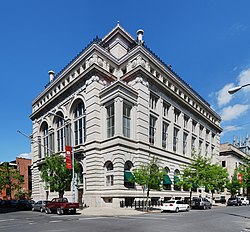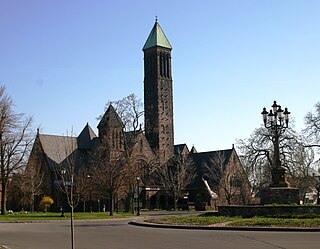
Symphony Hall is a concert hall located at 301 Massachusetts Avenue in Boston, Massachusetts, opened in 1900. Designed by the architectural firm McKim, Mead and White, it was built for the Boston Symphony Orchestra, which continues to make the hall its home. It can accommodate an audience of 2,625. The hall was designated a U.S. National Historic Landmark in 1999 and is a pending Boston Landmark. It was then noted that "Symphony Hall remains, acoustically, among the top three concert halls in the world, and is considered the finest in the United States." Symphony Hall, located one block from Berklee College of Music to the north and one block from the New England Conservatory to the south, also serves as home to the Boston Pops Orchestra as well as the site of many concerts of the Handel and Haydn Society.

The Royal Festival Hall is a 2,700-seat concert, dance and talks venue within Southbank Centre in London, England. It is situated on the South Bank of the River Thames, not far from Hungerford Bridge, in the London Borough of Lambeth. It is a Grade I listed building, the first post-war building to become so protected. The London Philharmonic Orchestra, the Philharmonia Orchestra, the Orchestra of the Age of Enlightenment, the London Sinfonietta, Chineke! and Aurora are resident orchestras at Southbank Centre.

The Hungarian State Opera House is a neo-Renaissance opera house located in central Budapest, on Andrássy út. Originally known as the Hungarian Royal Opera House, it was designed by Miklós Ybl, a major figure of 19th-century Hungarian architecture. Construction began in 1875, funded by the city of Budapest and by Emperor Franz Joseph I of Austria-Hungary, and the new house opened to the public on the 27 September 1884. Before the closure of the "Népszínház" in Budapest, it was the third largest opera building in the city; today it is the second largest opera house in Budapest and in Hungary.
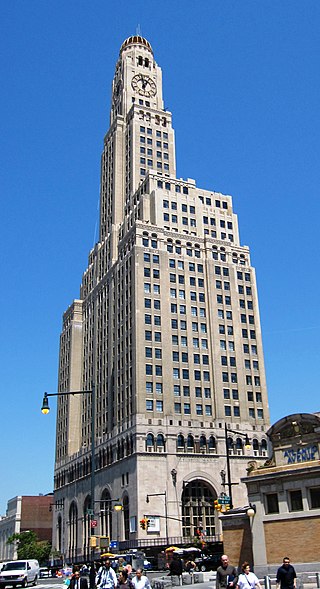
The Williamsburgh Savings Bank Tower, also known as One Hanson Place, is a skyscraper in the Fort Greene neighborhood of Brooklyn in New York City. Located at the northeast corner of Ashland Place and Hanson Place near Downtown Brooklyn, the tower was designed by Halsey, McCormack and Helmer and constructed from 1927 to 1929 as the new headquarters for the Williamsburgh Savings Bank. From the time of its construction until 2009, One Hanson Place was the tallest building in Brooklyn at 41 stories and 512 feet (156 m) tall.

The Stanley Theater at Kennedy Boulevard and Pavonia Avenue is near Journal Square in Jersey City, New Jersey.
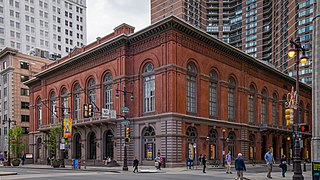
The Academy of Music, also known as American Academy of Music, is a concert hall and opera house located at 240 S. Broad Street in Philadelphia, Pennsylvania. Its location is between Locust and Manning Streets in the Avenue of the Arts area of Center City.

Alice Tully Hall is a concert hall at the Lincoln Center for the Performing Arts in the Upper West Side neighborhood of Manhattan in New York City. The hall is named for Alice Tully, a New York performer and philanthropist whose donations assisted in the construction of the hall. Tully Hall is located within the Juilliard Building, a Brutalist structure, which was designed by architect Pietro Belluschi. It was completed and subsequently opened in 1969. Since its opening, it has hosted numerous performances and events, including the New York Film Festival. Tully Hall seats 1,086 patrons. It is the home of the Chamber Music Society of Lincoln Center.

The Jesse H. Jones Hall for the Performing Arts is a performance venue in Houston, Texas, and the permanent home of the Houston Symphony Orchestra and Society for the Performing Arts. Jones Hall is also frequently rented as a venue for contemporary pop musicians and other performers and is estimated to draw over 400,000 audience members yearly.

The Music Hall, in Tarrytown, New York, United States, is located on West Main Street downtown. It is a brick structure in the Queen Anne architectural style erected in the late 19th century. In 1980, it was listed on the National Register of Historic Places.

Heinz Hall is a performing arts center and concert hall located at 600 Penn Avenue in the Cultural District of Pittsburgh, Pennsylvania. Home to the Pittsburgh Symphony Orchestra (PSO) and the Pittsburgh Youth Symphony Orchestra, the 2,676 seat hall presents about 200 performances each year. Originally built in 1927 as Loew's Penn Theatre, the former movie palace was renovated and reopened as Heinz Hall in 1971.

Proctor's Theatre is a theatre and former vaudeville house located in Schenectady, New York, United States. Many famous artists have performed there, including Mariah Carey, Britney Spears, Hal Holbrook, Ted Wiles, and George Burns, as well as many others. It has one of the largest movie screens in the Northeast.

The Saenger Theatre is a historic theater and contributing building to the Lower Dauphin Street Historic District in Mobile, Alabama. It was dedicated in January 1927. The Saenger Theatre is a Mobile landmark, known for its architecture and ties to local cultural history. The theater has been completely renovated in recent years with an upgraded electrical system, VIP facilities, new stage rigging and sound system. It is the official home of the Mobile Symphony Orchestra and also serves as the venue for movie festivals, concerts, lectures and special events.

The Palace Theatre is an entertainment venue in downtown Albany, New York, located on the corner of Clinton Avenue and North Pearl Street. The theatre is operated by the Palace Performing Arts Center, Inc - a 501(c)(3) non-profit organization. Established in 1984 and incorporated as a not-for-profit corporation in 1989, the Palace Performing Arts Center, Inc. was created to operate the theatre and utilize its full potential as a cultural and entertainment center in Albany.

49 Chambers, formerly known as the Emigrant Industrial Savings Bank Building and 51 Chambers Street, is a residential building at 49–51 Chambers Street in the Civic Center neighborhood of Manhattan in New York City. It was built between 1909 and 1912 and was designed by Raymond F. Almirall in the Beaux-Arts style. The building occupies a slightly irregular lot bounded by Chambers Street to the south, Elk Street to the east, and Reade Street to the north.

The Margot and Bill Winspear Opera House is an opera house located in the Arts District of downtown Dallas, Texas (USA).

The former Granada Cinema, also known as the Ebenezer Building or Cathedral of Christ Faith Tabernacle, in Woolwich, South East London, was built as a large and luxurious cinema in the 1930s. It had a seating capacity of nearly 2500 and is now being used as a church hall. The building with its extravagantly decorated interior is a Grade II* listed building.

The Greenwich Savings Bank Building, also known as the Haier Building and 1356 Broadway, is an office building at 1352–1362 Broadway in the Midtown Manhattan neighborhood of New York City. Constructed as the headquarters of the Greenwich Savings Bank from 1922 to 1924, it occupies a trapezoidal parcel bounded by 36th Street to the south, Sixth Avenue to the east, and Broadway to the west. The Greenwich Savings Bank Building was designed in the Classical Revival style by York and Sawyer.

The Bowery Savings Bank Building, also known as 130 Bowery, is an event venue and former bank building in the Little Italy and Chinatown neighborhoods of Lower Manhattan in New York City. Constructed for the defunct Bowery Savings Bank from 1893 to 1895, it occupies an "L"-shaped site bounded by Bowery to the east, Grand Street to the south, and Elizabeth Street to the west. The Bowery Savings Bank Building was designed by Stanford White of McKim, Mead & White. Since 2002, it has hosted an event venue called Capitale. The building's facade and interior are New York City designated landmarks, and the building is listed on the National Register of Historic Places.
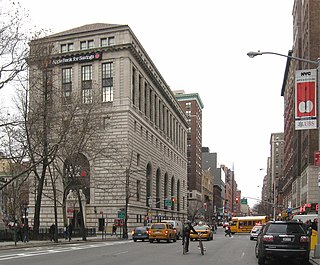
The Apple Bank Building, also known as the Central Savings Bank Building and 2100 Broadway, is a bank and residential building at 2100–2114 Broadway on the Upper West Side of Manhattan in New York City, New York, United States. Constructed as a branch of the Central Savings Bank from 1926 to 1928, it occupies a trapezoidal city block bounded by 73rd Street to the south, Amsterdam Avenue to the east, 74th Street to the north, and Broadway to the west. The Apple Bank Building was designed by York and Sawyer in the Renaissance Revival and palazzo styles, patterned after an Italian Renaissance-style palazzo.
